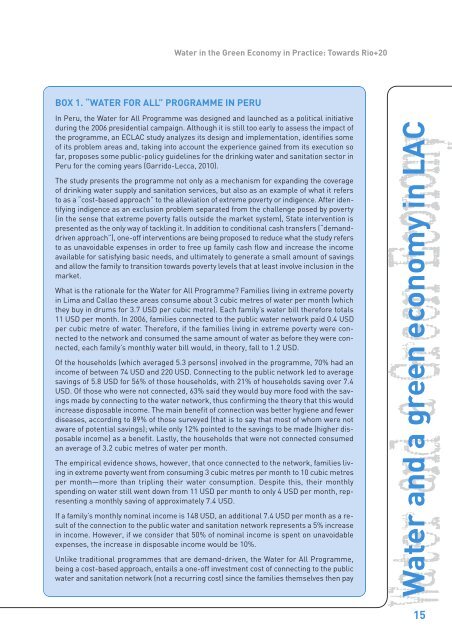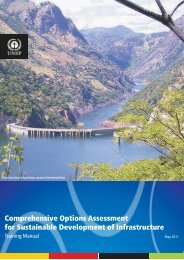Water and a Green Economy in Latin America and the Caribbean
Water and a Green Economy in Latin America and the Caribbean
Water and a Green Economy in Latin America and the Caribbean
Create successful ePaper yourself
Turn your PDF publications into a flip-book with our unique Google optimized e-Paper software.
<strong>Water</strong> <strong>in</strong> <strong>the</strong> <strong>Green</strong> <strong>Economy</strong> <strong>in</strong> Practice: Towards Rio+20<br />
BOX 1. “WATER FOR ALL” PROGRAMME IN PERU<br />
In Peru, <strong>the</strong> <strong>Water</strong> for All Programme was designed <strong>and</strong> launched as a political <strong>in</strong>itiative<br />
dur<strong>in</strong>g <strong>the</strong> 2006 presidential campaign. Although it is still too early to assess <strong>the</strong> impact of<br />
<strong>the</strong> programme, an ECLAC study analyzes its design <strong>and</strong> implementation, identifies some<br />
of its problem areas <strong>and</strong>, tak<strong>in</strong>g <strong>in</strong>to account <strong>the</strong> experience ga<strong>in</strong>ed from its execution so<br />
far, proposes some public-policy guidel<strong>in</strong>es for <strong>the</strong> dr<strong>in</strong>k<strong>in</strong>g water <strong>and</strong> sanitation sector <strong>in</strong><br />
Peru for <strong>the</strong> com<strong>in</strong>g years (Garrido-Lecca, 2010).<br />
The study presents <strong>the</strong> programme not only as a mechanism for exp<strong>and</strong><strong>in</strong>g <strong>the</strong> coverage<br />
of dr<strong>in</strong>k<strong>in</strong>g water supply <strong>and</strong> sanitation services, but also as an example of what it refers<br />
to as a “cost-based approach” to <strong>the</strong> alleviation of extreme poverty or <strong>in</strong>digence. After identify<strong>in</strong>g<br />
<strong>in</strong>digence as an exclusion problem separated from <strong>the</strong> challenge posed by poverty<br />
(<strong>in</strong> <strong>the</strong> sense that extreme poverty falls outside <strong>the</strong> market system), State <strong>in</strong>tervention is<br />
presented as <strong>the</strong> only way of tackl<strong>in</strong>g it. In addition to conditional cash transfers (“dem<strong>and</strong>driven<br />
approach”), one-off <strong>in</strong>terventions are be<strong>in</strong>g proposed to reduce what <strong>the</strong> study refers<br />
to as unavoidable expenses <strong>in</strong> order to free up family cash flow <strong>and</strong> <strong>in</strong>crease <strong>the</strong> <strong>in</strong>come<br />
available for satisfy<strong>in</strong>g basic needs, <strong>and</strong> ultimately to generate a small amount of sav<strong>in</strong>gs<br />
<strong>and</strong> allow <strong>the</strong> family to transition towards poverty levels that at least <strong>in</strong>volve <strong>in</strong>clusion <strong>in</strong> <strong>the</strong><br />
market.<br />
What is <strong>the</strong> rationale for <strong>the</strong> <strong>Water</strong> for All Programme? Families liv<strong>in</strong>g <strong>in</strong> extreme poverty<br />
<strong>in</strong> Lima <strong>and</strong> Callao <strong>the</strong>se areas consume about 3 cubic metres of water per month (which<br />
<strong>the</strong>y buy <strong>in</strong> drums for 3.7 USD per cubic metre). Each family’s water bill <strong>the</strong>refore totals<br />
11 USD per month. In 2006, families connected to <strong>the</strong> public water network paid 0.4 USD<br />
per cubic metre of water. Therefore, if <strong>the</strong> families liv<strong>in</strong>g <strong>in</strong> extreme poverty were connected<br />
to <strong>the</strong> network <strong>and</strong> consumed <strong>the</strong> same amount of water as before <strong>the</strong>y were connected,<br />
each family’s monthly water bill would, <strong>in</strong> <strong>the</strong>ory, fall to 1.2 USD.<br />
Of <strong>the</strong> households (which averaged 5.3 persons) <strong>in</strong>volved <strong>in</strong> <strong>the</strong> programme, 70% had an<br />
<strong>in</strong>come of between 74 USD <strong>and</strong> 220 USD. Connect<strong>in</strong>g to <strong>the</strong> public network led to average<br />
sav<strong>in</strong>gs of 5.8 USD for 56% of those households, with 21% of households sav<strong>in</strong>g over 7.4<br />
USD. Of those who were not connected, 63% said <strong>the</strong>y would buy more food with <strong>the</strong> sav<strong>in</strong>gs<br />
made by connect<strong>in</strong>g to <strong>the</strong> water network, thus confirm<strong>in</strong>g <strong>the</strong> <strong>the</strong>ory that this would<br />
<strong>in</strong>crease disposable <strong>in</strong>come. The ma<strong>in</strong> benefit of connection was better hygiene <strong>and</strong> fewer<br />
diseases, accord<strong>in</strong>g to 89% of those surveyed (that is to say that most of whom were not<br />
aware of potential sav<strong>in</strong>gs); while only 12% po<strong>in</strong>ted to <strong>the</strong> sav<strong>in</strong>gs to be made (higher disposable<br />
<strong>in</strong>come) as a benefit. Lastly, <strong>the</strong> households that were not connected consumed<br />
an average of 3.2 cubic metres of water per month.<br />
The empirical evidence shows, however, that once connected to <strong>the</strong> network, families liv<strong>in</strong>g<br />
<strong>in</strong> extreme poverty went from consum<strong>in</strong>g 3 cubic metres per month to 10 cubic metres<br />
per month—more than tripl<strong>in</strong>g <strong>the</strong>ir water consumption. Despite this, <strong>the</strong>ir monthly<br />
spend<strong>in</strong>g on water still went down from 11 USD per month to only 4 USD per month, represent<strong>in</strong>g<br />
a monthly sav<strong>in</strong>g of approximately 7.4 USD.<br />
If a family’s monthly nom<strong>in</strong>al <strong>in</strong>come is 148 USD, an additional 7.4 USD per month as a result<br />
of <strong>the</strong> connection to <strong>the</strong> public water <strong>and</strong> sanitation network represents a 5% <strong>in</strong>crease<br />
<strong>in</strong> <strong>in</strong>come. However, if we consider that 50% of nom<strong>in</strong>al <strong>in</strong>come is spent on unavoidable<br />
expenses, <strong>the</strong> <strong>in</strong>crease <strong>in</strong> disposable <strong>in</strong>come would be 10%.<br />
Unlike traditional programmes that are dem<strong>and</strong>-driven, <strong>the</strong> <strong>Water</strong> for All Programme,<br />
be<strong>in</strong>g a cost-based approach, entails a one-off <strong>in</strong>vestment cost of connect<strong>in</strong>g to <strong>the</strong> public<br />
water <strong>and</strong> sanitation network (not a recurr<strong>in</strong>g cost) s<strong>in</strong>ce <strong>the</strong> families <strong>the</strong>mselves <strong>the</strong>n pay<br />
<strong>Water</strong><strong>and</strong>a<strong>Green</strong><strong>Economy</strong><br />
<strong>and</strong> a green economy <strong>in</strong> LAC<br />
15

















